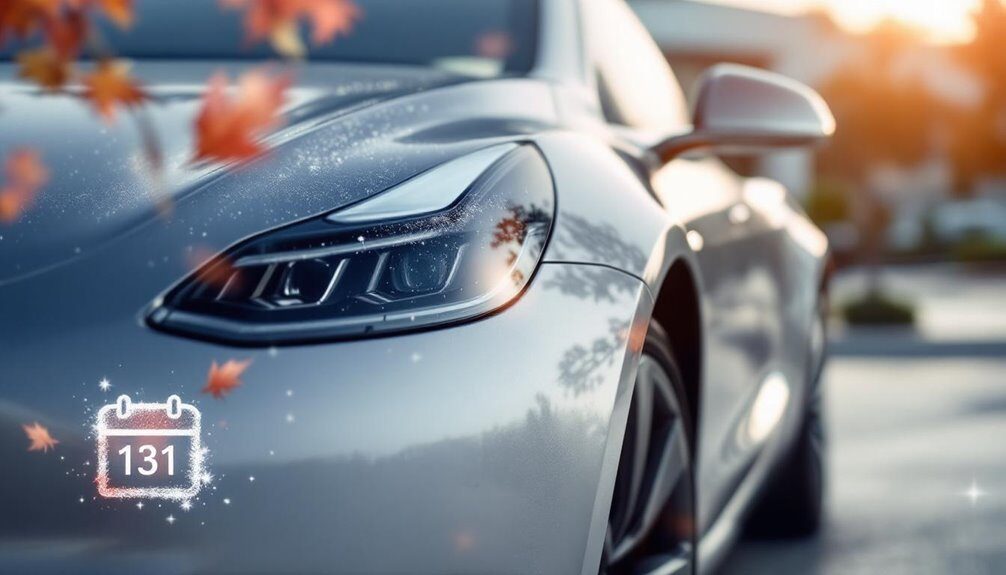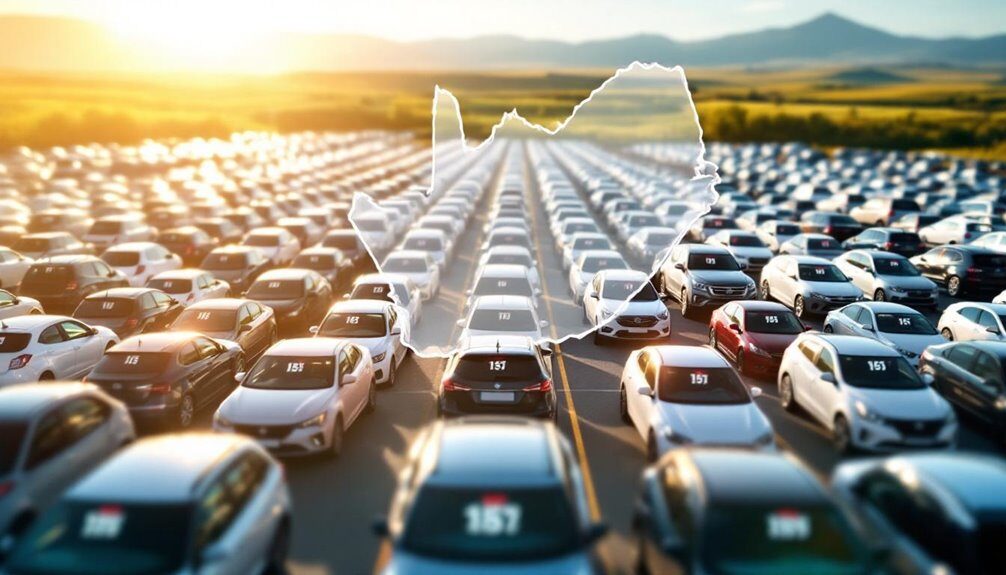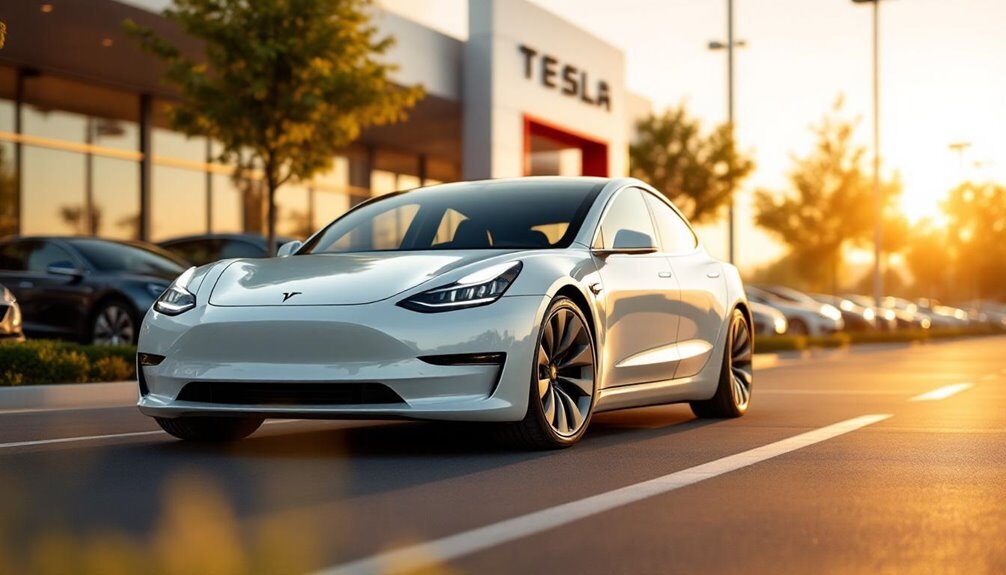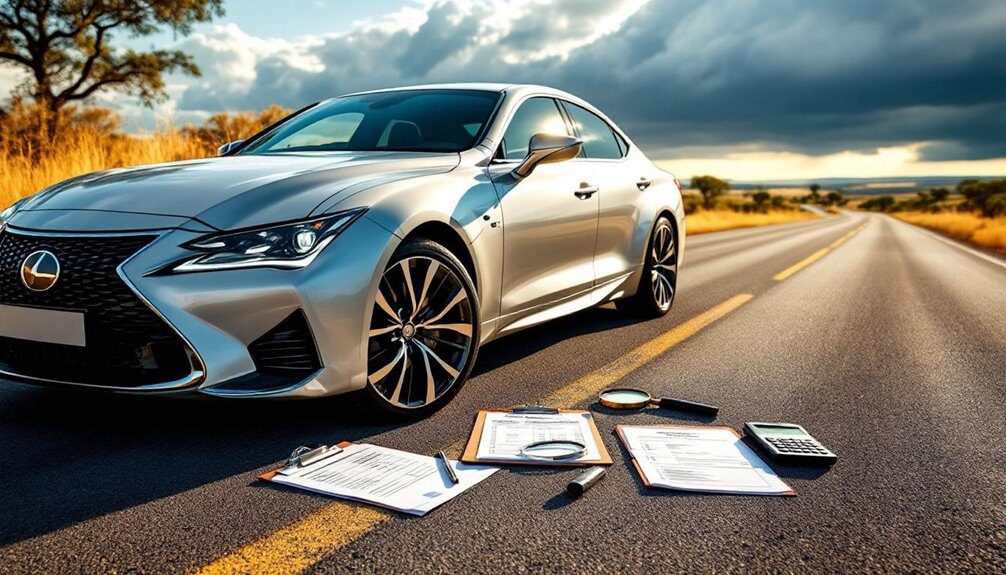You’re looking at a buyer’s market right now—Chinese and Indian automakers have flooded South Africa with dirt-cheap options, forcing established brands like Toyota and Volkswagen to slash prices. You can snag a reliable new car starting around R178,800 without sacrificing dependability or modern tech like touchscreen infotainment and smartphone integration. Models like the Toyota Vitz, Suzuki S-Presso, and Tata Tiago deliver solid build quality, fuel efficiency around 4.2–4.8 L/100 km, and resale value that won’t tank. Monthly running costs hover around R3,500–R5,000 when you factor in fuel, insurance, and maintenance. Stick around to uncover which model matches your wallet and driving style best.
Top 5 Most Affordable New Cars for Students in 2026
Let’s cut through the noise. You’re skint. We get it. But you still need wheels.
You’re skint. We get it. But you still need wheels.
The Renault Kwid kicks off at R196,999—basically pocket change for a car. The Toyota Vitz and Suzuki S-Presso both hover around R178,800 to R178,900. Practically twins, really. Both pack 1.0-litre engines with manual or automatic options. The Suzuki Celerio sits at R188,900 and shares the same reliable guts as the Vitz. The Celerio’s 4.6 L/100 km fuel consumption makes it one of the most efficient options in this price bracket.
Then there’s the Tata Tiago at R184,900. Solid build, modern infotainment, decent power. If you need financing support, reputable dealers like Autobahn Motors partner with major financing institutions to make these affordable cars even more accessible.
Here’s the thing: all five are actually dependable. No surprises. No sudden breakdowns draining your student budget further. They’re stripped-down, practical, and built to last. Perfect for someone starting out. At Autobahn Motors, we understand that reliable vehicle upkeep is essential for keeping your affordable car on the road without unexpected costs. The 5-speed manual gearboxes available across these models keep maintenance costs minimal and repairs straightforward at any local workshop.
Understanding Fuel Efficiency and Monthly Running Costs
You’re probably wondering why your mate’s tiny 1.2-litre hatchback costs almost nothing to run whilst your cousin’s V6 SUV bleeds money at every petrol station—that’s fuel efficiency in action, and it’s gonna hit your monthly budget hard.
Engine size matters big time: smaller displacement typically means better km/l figures, though you’re trading some grunt for those savings.
Modern compact cars pull off around 5-7 l/100km in mixed driving, which sounds technical until you do the maths and realise you’re looking at roughly 3,500–5,000 ZAR monthly for fuel and basic upkeep versus way more for thirstier alternatives. Regular oil and filter changes will keep your engine running efficiently and help maintain those fuel economy figures. Keeping up with scheduled maintenance services at a trusted service centre ensures your vehicle stays in peak condition, which directly impacts fuel efficiency and long-term running costs. With South Africa’s carbon tax now at R236/tCO2e as of 2025, fuel costs may rise further, making fuel-efficient vehicles even more attractive for budget-conscious students.
Fuel Consumption Comparison Metrics
Regarding buying a cheap reliable car in South Africa, fuel consumption isn’t some boring spec sheet detail—it’s literally money flowing out of your tank every single day.
Here’s the thing: fuel consumption measures how many litres you’ll burn per 100 kilometres. Lower numbers? That’s your wallet staying fuller. The Suzuki Celerio guzzles just 4.2 L/100km. The Renault Kwid? 4.7 L/100km. That difference adds up fast when you’re grinding through city traffic daily.
Small petrol engines dominate this segment because they’re affordable and efficient. Manual transmissions usually edge out automatics. Your driving style matters too—aggressive acceleration kills your numbers. When selecting your vehicle, consider models with proven track records and engine reliability that won’t drain your budget with unexpected repairs.
Real-world conditions beat rated figures every time, but those L/100km benchmarks give you solid comparison ground. Beyond fuel efficiency, partnering with a trusted dealer offering routine maintenance and regular check-ups ensures your affordable car stays reliable and runs optimally over time.
Monthly Budget Impact Analysis
Your monthly running costs aren’t just about the petrol pump. Insurance hits R300 to R900 monthly. Maintenance runs around R475. Registration fees tack on another R42 to R125. Then there’s depreciation—roughly R4,500 monthly on a mid-range vehicle, which sounds dramatic because it *is*.
Stack these up:
- Fuel consumption consuming 15–25% of your R6,000–R9,000 monthly income
- Insurance premiums ranging R300–R900 depending on coverage
- Routine maintenance averaging R475 for mid-range vehicles
- Vehicle depreciation representing 18% annually on resale value
The numbers? They’re tight. But choosing a reliable, fuel-efficient model cuts the damage. Regular brake maintenance and other essential services keep your vehicle operating safely and help preserve its resale value over time. Professional tyre services including inspections, rotations, and balancing extend tyre lifespan and improve fuel efficiency.
Engine Size and Efficiency
Engine displacement—that’s the real culprit behind whether you’re spending R800 or R1,200 monthly on fuel. Small 1.0-litre engines? They’re sipping fuel at 4.2 to 4.9 L/100km. Move up to 1.2-litres and you’re looking at 4.4 to 5.7 L/100km. Jump to 1.4 or 1.5-litres and consumption climbs to 5.4 to 6.4 L/100km. Each extra 0.2 litres of displacement typically adds another 0.5 to 1.0 L/100km.
The Suzuki Celerio crushes it at 4.2 L/100km with its 1.0-litre engine. Boosted options like the Polo Vivo 1.0TSI deliver power without sacrificing efficiency—hitting 4.8 L/100km. When selecting your vehicle, ensure you source quality OEM parts from reputable suppliers to maintain optimal fuel efficiency over time. Bottom line: smaller displacement means your money lasts longer. For personalised guidance on selecting the most fuel-efficient vehicle for your budget, comprehensive automotive care and maintenance experts can help you evaluate your options based on real-world running costs.
Essential Safety Features Every Young Driver Should Know About
When you’re behind the wheel for the first time, you’re not just piloting a hunk of metal down the road—you’re trusting your life to a bunch of safety systems you’ve probably never thought about.
You’re trusting your life to safety systems you’ve probably never thought about when you’re behind the wheel for the first time.
Here’s what actually matters:
- Anti-lock Braking System (ABS) prevents your wheels from locking up during hard braking, so you keep steering control when things go sideways
- Electronic Stability Control (ESC) helps you stay in control during skids or when traction disappears
- Airbags (front and side) provide critical protection in collisions—they’re basically your invisible bodyguards
- Functional lights and head restraints reduce neck injuries and keep you visible to other drivers
Look for these features when shopping.
Don’t settle for older vehicles lacking modern safety tech.
Your life literally depends on it.
Financing Options and Subscription Services Available
Buying a cheap reliable car in South Africa doesn’t mean you’re stuck with one financing option—you’ve got several paths forward, each with its own quirks and trade-offs.
Traditional bank loans offer lower interest rates but demand thorough documentation and credit checks.
Dealership financing? Faster approval. Higher rates, though.
Hire purchase agreements let you drive whilst you pay—ownership comes after the final payment lands.
Then there’s leasing and subscription services if you’re not ready to commit.
Some finance partners offer Guaranteed Future Value agreements that defer a chunk of the vehicle’s cost, letting you upgrade frequently.
The key? Compare what fits your budget and situation.
Don’t just grab the first option.
Comparing Boot Space and Interior Practicality
You’re probably wondering whether you should go hatchback or saloon when you’re shopping for something cheap and reliable in 2026—and honestly, boot space matters way more than you think when you’re juggling groceries, tools, or just your entire life.
Hatchbacks like the Toyota Vitz and Suzuki Swift pack decent cargo flexibility with split-folding rear seats, but if you need genuine hauling capacity without the saloon’s boot limitations, the Tata Nexon’s 382 litres blows them out of the water.
The real trade-off? Saloons give you separation between passengers and cargo; hatchbacks give you versatility and easier access—pick whichever actually fits how you’ll use the car.
Hatchbacks Vs Saloon Storage
The boot space battle comes down to this: saloons pack more cubic litres into a dedicated boot, while hatchbacks sacrifice raw capacity for something arguably—some would say—better—adaptability.
You’re looking at saloons offering 500+ litres versus hatchbacks’ 311-351 litres. Sounds like saloons win, right? Not so fast.
Here’s what actually matters for your lifestyle:
- Folding seats flatten everything. Hatchbacks convert into cargo vans; saloons? Stuck with fixed bulkheads.
- Easy loading beats boot openings. That rear hatch beats wrestling bulky items through a narrow saloon boot lid.
- Urban parking demands practicality. Lower height, wider access—hatchbacks dominate day-to-day hauling.
- Security costs flexibility. Saloons isolate boot contents from thieves, but you’re locked into their predetermined space.
Bottom line: saloons store more. Hatchbacks store *anything*.
Passenger Comfort and Versatility
The Toyota Vitz and Suzuki Swift deliver spacious interiors with legroom that doesn’t feel cramped.
The Tata Nexon? It throws in modern ergonomics and supportive seating designed for actual South African road conditions.
Meanwhile, the Renault Triber pulls off the supreme flex with multi-seat configurations—shift from passengers to cargo in seconds.
Budget models like the Hyundai Grand i10 make the most of every inch, whilst touchscreen infotainment and dual airbags across Suzuki and Hyundai lineups keep you connected and safer.
Your car isn’t just transport. It’s where you live.
Insurance Premiums for Budget-Friendly Models
When you’re shopping for a cheap, reliable car in South Africa, here’s the thing—insurance costs’ll make or break your budget faster than a pothole on a rural road.
Budget-friendly models like the Suzuki Swift and Toyota Corolla won’t drain your wallet on premiums, but you’ve got options to squeeze savings even tighter.
Here’s what actually works:
- Third-party insurance runs as low as R70 monthly for budget vehicles
- all-risk cover ranges R390–R470 for hatchbacks and saloons
- Parking in secure locations directly lowers your risk profile
- Low annual mileage through telematics schemes cuts premiums substantially
Young drivers face higher premiums overall—that’s just reality.
Smaller engines and good safety ratings help.
Skip the flashy stuff.
Compare policies seriously.
The cheapest option isn’t always your best play.
Reliability and Resale Value Considerations
If you’re buying cheap in 2026, resale value’s going to matter—especially when you’re stretched thin on cash. Toyota and Hyundai models hold their worth better. Why? Strong brand reputation, proven reliability, low maintenance costs.
The Suzuki Swift crushes it past 140,000 miles. That matters when you’re eventually selling.
Warranty coverage impacts resale pricing hard. Extended warranties signal durability to buyers. Hybrid variants like the Corolla Cross? Battery warranties enhance buyer confidence, which means better resale numbers down the road.
Fuel efficiency plays a role too. Cheaper to run means more people want them used. Basically, picking reliable brands now means less financial bleeding when you eventually offload the car.
Manual vs. Automatic Transmissions: Which Is Right for You
Picking the right transmission matters just as much as choosing a reliable brand—perhaps more, actually. Here’s the thing: you’ve got two camps, and they’re basically fighting it out.
Manual transmissions demand more from you. They’re distracting. Extra pedal, gear stick, constant multitasking. Older drivers and newbies? Yeah, that’s a recipe for mistakes. But they’ve historically been cheaper to buy and maintain.
Automatics? They’ve won the fuel efficiency war by 2022. They’re smoother, faster, easier. Less workload means you can actually focus on the road instead of juggling three pedals.
Consider this:
- Automatics shift faster than humans can
- Manuals increase crash risk through distraction
- Modern automatics now beat manuals on MPG
- Automatics handle stop-and-go traffic way better
Your call depends on experience level and daily driving reality.
Modern Connectivity and Tech Features in Entry-Level Cars
You’re getting touchscreen infotainment systems as standard now—even in budget entry-level cars like the Suzuki Fronx—which honestly used to be a luxury thing.
Your smartphone connects seamlessly via wireless Apple CarPlay and Android Auto, plus you’ve got Bluetooth for hands-free calls and music streaming, so you’re basically living in 2026 tech whether you paid for a fancy trim or not.
The digital dashboards aren’t just gauges anymore; they’re feeding you trip metres, fuel economy data, and real-time vehicle status, which beats staring at boring analogue needles any day.
Touchscreen Infotainment Systems
Modern connectivity’s taken over the entry-level car game—and honestly, it’s hard to complain. You’re getting touchscreen infotainment systems that rival way pricier vehicles. The Tata Tiago, Punch, and Curvv all pack 7 to 10.25-inch displays. Suzuki Fronx throws a 9-inch screen at you. These aren’t gimmicks either—they actually work.
Here’s what you’re really getting:
- Apple CarPlay and Android Auto on basically everything
- Steering wheel audio controls for hands-free operation
- Rearview cameras standard across most models
- 360-degree cameras on higher trims for those who want zero blind spots
Smartphone mirroring’s seamless. Guidance, music, calls—all integrated.
Physical buttons complement the touchscreens so you’re not fumbling like an idiot whilst driving. These systems feel modern without feeling bloated.
Smart Connectivity Features
Whilst touchscreens grab the headlines, what’s really reshaping entry-level cars is what happens when your phone actually talks to your vehicle.
The Tata Punch and Tiago offer wireless Apple CarPlay and Android Auto as standard—no cables required. The Harrier steps it up with Alexa Car2Home connectivity, letting you control your ride and your home from the same voice commands. The Suzuki Victoris launches Q1 2026 with Amazon Alexa built in. Your climate, entertainment, routing? All hands-free.
The Chery iCar 03 boasts a 15.4-inch touchscreen with universal phone and tablet mounts that actually work. These cars speak your tech language. Cross-platform compatibility means you’re not locked into one ecosystem. Your devices, your rules.
Digital Dashboard Integration
Ditching those cramped, monochrome instrument clusters? Yeah, entry-level cars in 2026 aren’t playing that game anymore. You’re getting digital dashboards that actually look modern—think 10.25-inch to 14.6-inch displays that adjust to how you’re driving. The BAIC B30 ships with a standard digital cluster. Suzuki Victoris tops are getting them too.
Here’s what you’re looking at:
- Adaptive displays that switch themes based on driving modes (eco, sport, off-road)
- Real-time ADAS alerts integrated directly into your dashboard
- Customisable widgets and colour schemes you can tweak
- Split-screen functionality for quick access menus
And don’t worry—physical buttons still exist. Touchscreens handle the fancy stuff, but climate controls and drive mode selectors? Still tactile. You get both worlds.
Market Trends Shaping Affordable Car Choices in 2026
As affordability pressures squeeze South African wallets in 2026, the car market’s shifting dramatically—and it’s not just about price tags.
You’re seeing Chinese and Indian automakers flood the market with dirt-cheap options, forcing established brands like Toyota and Volkswagen to fight back with aggressive pricing. Interest rate cuts are finally making monthly payments breathable.
Chinese and Indian automakers are forcing pricing wars, whilst interest rate cuts finally make car payments affordable for everyday buyers.
Here’s the kicker: the used car market’s exploding. More affordable pre-owned vehicles hit dealer lots every month, creating genuine choice for students and young drivers who can’t touch new car prices.
Dealers are stocking smarter too—focusing on reliable, dependable vehicles instead of flashy stuff nobody can afford. Value’s winning. Prestige badges? They’re getting demolished.




